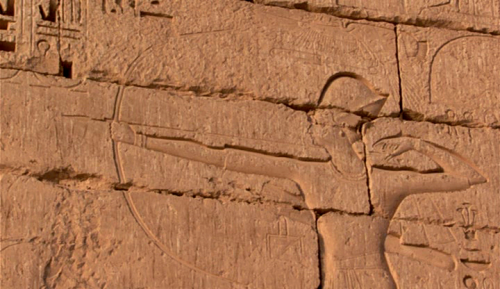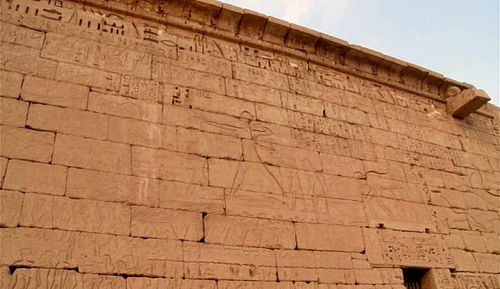Ancient Worlds - BBC TwoEpisode 2 “The Age of Iron”Medinet Habu, The Mortuary Temple of
Ancient Worlds - BBC TwoEpisode 2 “The Age of Iron”Medinet Habu, The Mortuary Temple of Ramesses III at Thebes. The temple decoration consists of a series of reliefs and texts paying tribute to the pharaoh and his many accomplishments. The murals depicting the battles between Egypt and the Sea Peoples (about 1190 BC) are located on the northern outside wall of the temple. The texts and reliefs regarding the Sea Peoples provide an account of Egypt’s campaign against the “coalition of the sea” from an Egyptian point of view. Rameses III is depicted with his bow drawn, gigantic, while the warships of the invaders gather around his feet; it is a triumphant, propagandistic image of total annihilation. The inscriptions of the pharaoh at his temple record three victorious campaigns against the Sea Peoples.According to Egyptian accounts the Sea Peoples, a group of distinct peoples of diverse origins, were named as the Peleset, Tjeker, Shekelesh, Denyen, Habiru and Weshesh. Scholars have tried to identify these places as mainland Italy, Sardinia, Sicily, the islands of the Aegean, Palestine and even Minoan Crete and Anatolia, but such claims still remain mere conjecture. The Medinet Habu reliefs provide valuable information about the appearance and accoutrements of the various groups. Egypt was one of the few civilizations that managed to survive the onslaught of the Sea Peoples but in the following years they appeared in greater numbers, leaving the Egyptians more vulnerable, incapable of defending their possessions in the East.Medinet Habu, Theban Necropolis, Luxor, Egypt -- source link
Tumblr Blog : richard-miles-archaeologist.tumblr.com
#richard miles#ancient worlds#medinet habu#ramses iii#ancient egypt#thebes#relief#theban necropolis#new kingdom#bbc two#screencap





